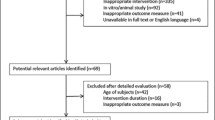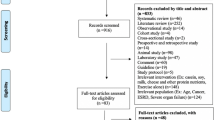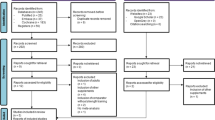Abstract
Objectives
The objective of this study was to perform a systematic review to investigate the effects protein, essential amino acids (EAA), β-hydroxy β-methylbutyrate (HMB), creatine, dehydroepiandrosterone (DHEA) and fatty acid supplementation on muscle mass, muscle strength and physical performance of elderly subjects.
Methods
Using the electronic databases MEDLINE and EMBASE we identified RCTs published until February 2016 which assessed the effects of these nutrient supplementation on muscle strength, muscle mass or physical performance. Study selection and data extraction were performed by two independent reviewers.
Results
Search strategy allowed us to identify 23 RCTs. Among them, four used proteins as nutritional supplement, seven EAAs, six creatine, four DHEA and finally, two HMB. From our systematic review, it seems that the effects of these supplementations on muscle health are rather limited. Only consistent effects of EAA supplementation on physical performance (3 out of the 4 RCTs using EAA supplementation found significant effect of this supplementation on physical performance) and HMB supplementation on muscle mass (all the 2 identified RCTs using HMB supplementation found significant effect of this supplementation on muscle mass) have been found across studies. No consistent effects were found for the other types of dietary supplementation. Because of the important limitations in study design, inconsistency and lack of directness, the overall quality of the evidence was judged to be low or very low using the GRADE system.
Conclusion
This systematic review showed a limited effect of nutritional supplementation on muscle mass, muscle power and physical function. Inconsistent positive effects were observed for some specific supplementations but the results only concerned one aspect of the muscle. Well designed and appropriately powered RCTs are needed to provide evidence for appropriate clinical recommendations.










Similar content being viewed by others
References
Dodds, R. M. et al. Grip strength across the life course: normative data from twelve British studies. PLoS One 2014;9, e113637.
Frontera, W. R. et al. Aging of skeletal muscle: a 12-yr longitudinal study. J. Appl. Physiol. 2000;88, 1321–6.
Rolland, Y. M., Perry, H. M., Patrick, P., Banks, W. A. & Morley, J. E. Loss of appendicular muscle mass and loss of muscle strength in young postmenopausal women. J. Gerontol. A. Biol. Sci. Med. Sci. 2007;62, 330–5.
Beaudart, C., Rizzoli, R., Bruyère, O., Reginster, J.-Y. & Biver, E. Sarcopenia: burden and challenges for public health. Archives of Public Health 2014;72, 45.
Rizzoli, R. et al. Quality of life in sarcopenia and frailty. Calcif Tissue Int 2013;93, 101–120.
Denison, H. J., Cooper, C., Sayer, A. A. & Robinson, S. M. Prevention and optimal management of sarcopenia: a review of combined exercise and nutrition interventions to improve muscle outcomes in older people. Clin. Interv. Aging 2015;10, 859–69.
Robinson, S., Cooper, C. & Aihie Sayer, A. Nutrition and sarcopenia: a review of the evidence and implications for preventive strategies. J Aging Res 2012, 510801.
Malafarina, V., Uriz-Otano, F., Iniesta, R. & Gil-Guerrero, L. Effectiveness of nutritional supplementation on muscle mass in treatment of sarcopenia in old age: a systematic review. J Am Med Dir Assoc 2013;14, 10–17.
Cermak, N. M., Res, P. T., de Groot, L. C. P. G. M., Saris, W. H. M. & van Loon, L. J. C. Protein supplementation augments the adaptive response of skeletal muscle to resistance-type exercise training: a meta-analysis. Am. J. Clin. Nutr. 2012;96, 1454–64.
Corona, G. et al. Dehydroepiandrosterone supplementation in elderly men: a metaanalysis study of placebo-controlled trials. J. Clin. Endocrinol. Metab. 2013;98, 3615–26.
Devries, M. C. & Phillips, S. M. Creatine supplementation during resistance training in older adults-a meta-analysis. Med. Sci. Sports Exerc. 2014;46, 1194–203.
Finger, D. et al. Effects of protein supplementation in older adults undergoing resistance training: a systematic review and meta-analysis. Sports Med. 2015;45, 245–55.
Molfino, A., Gioia, G., Rossi Fanelli, F. & Muscaritoli, M. Beta-hydroxy-betamethylbutyrate supplementation in health and disease: a systematic review of randomized trials. Amino Acids 2013;45, 1273–92.
Cruz-Jentoft, A. J. et al. Prevalence of and interventions for sarcopenia in ageing adults: a systematic review. Report of the International Sarcopenia Initiative (EWGSOP and IWGS). Age Ageing, 2014. doi:https://doi.org/10.1093/ageing/afu115
Potter, J. et al. Routine protein energy supplementation in adults: systematic review. BMJ 1998;317, 495–501.
Cawood, A. L., Elia, M. & Stratton, R. J. Systematic review and meta-analysis of the effects of high protein oral nutritional supplements. Ageing Res. Rev. 2012;11, 278–96.
Jadad, A. R. et al. Assessing the quality of reports of randomized clinical trials: is blinding necessary? Control Clin Trials 1996;17, 1–12.
Kerstetter, J. E. et al. The Effect of a Whey Protein Supplement on Bone Mass in Older Caucasian Adults. J. Clin. Endocrinol. Metab. 2015;100, 2214–22.
Tieland, M. et al. Protein supplementation improves physical performance in frail elderly people: a randomized, double-blind, placebo-controlled trial. J Am Med Dir Assoc 2012;13, 720–726.
Zhu, K. et al. Two-Year Whey Protein Supplementation Did Not Enhance Muscle Mass and Physical Function in Well-Nourished Healthy Older Postmenopausal Women. J. Nutr. 2015;145, 2520–6.
Björkman, M. P., Finne-Soveri, H. & Tilvis, R. S. Whey protein supplementation in nursing home residents. A randomized controlled trial. Eur. Geriatr. Med. 2012;3, 161–166.
Szcześniak, D., Budzeń, S., Kopeć, W. & Rymaszewska, J. Anserine and carnosine supplementation in the elderly: Effects on cognitive functioning and physical capacity. Arch. Gerontol. Geriatr. 59, 485–90
del Favero, S. et al. Beta-alanine (CarnosynTM) supplementation in elderly subjects (60-80 years): effects on muscle carnosine content and physical capacity. Amino Acids 2012;43, 49–56.
Rondanelli, M. et al. Effect of essential amino acid supplementation on quality of life, amino acid profile and strength in institutionalized elderly patients. Clin. Nutr. 2011;30, 571–7.
Ferrando, A. A. et al. EAA supplementation to increase nitrogen intake improves muscle function during bed rest in the elderly. Clin. Nutr. 2010;29, 18–23.
Dillon, E. L. et al. Amino acid supplementation increases lean body mass, basal muscle protein synthesis, and insulin-like growth factor-I expression in older women. J. Clin. Endocrinol. Metab. 2009;94, 1630–7.
Verhoeven, S. et al. Long-term leucine supplementation does not increase muscle mass or strength in healthy elderly men. Am. J. Clin. Nutr. 2009;89, 1468–75.
Scognamiglio, R., Piccolotto, R., Negut, C., Tiengo, A. & Avogaro, A. Oral amino acids in elderly subjects: effect on myocardial function and walking capacity. Gerontology 51, 302–8
Gualano, B. et al. Creatine supplementation and resistance training in vulnerable older women: a randomized double-blind placebo-controlled clinical trial. Exp. Gerontol. 2014;53, 7–15.
Alves, C. R. R. et al. Creatine supplementation associated or not with strength training upon emotional and cognitive measures in older women: a randomized double-blind study. PLoS One 2013;8, e76301.
Rawson, E. S. & Clarkson, P. M. Acute creatine supplementation in older men. Int. J. Sports Med. 2000;21, 71–5.
Bermon, S., Venembre, P., Sachet, C., Valour, S. & Dolisi, C. Effects of creatine monohydrate ingestion in sedentary and weight-trained older adults. Acta Physiol. Scand. 1998;164, 147–55.
Wiroth, J. B. et al. Effects of oral creatine supplementation on maximal pedalling performance in older adults. Eur. J. Appl. Physiol. 2001;84, 533–9.
Jakobi, J. M., Rice, C. L., Curtin, S. V & Marsh, G. D. Neuromuscular properties and fatigue in older men following acute creatine supplementation. Eur. J. Appl. Physiol. 2001;84, 321–8.
Nair, K. S. et al. DHEA in elderly women and DHEA or testosterone in elderly men. N. Engl. J. Med. 2006;355, 1647–59.
Flynn, M. A., Weaver-Osterholtz, D., Sharpe-Timms, K. L., Allen, S. & Krause, G. Dehydroepiandrosterone replacement in aging humans. J. Clin. Endocrinol. Metab. 1999;84, 1527–33.
Villareal, D. T. & Holloszy, J. O. DHEA enhances effects of weight training on muscle mass and strength in elderly women and men. Am. J. Physiol. Endocrinol. Metab. 2006;291, E1003–8.
Percheron, G. et al. Effect of 1-year oral administration of dehydroepiandrosterone to 60- to 80-year-old individuals on muscle function and cross-sectional area: a doubleblind placebo-controlled trial. Arch. Intern. Med. 2003;163, 720–7.
Stout, J. R. et al. Effect of calcium β-hydroxy-β-methylbutyrate (CaHMB) with and without resistance training in men and women 65+yrs: a randomized, double-blind pilot trial. Exp. Gerontol. 2013;48, 1303–10.
Deutz, N. E. P. et al. Effect of β-hydroxy-β-methylbutyrate (HMB) on lean body mass during 10 days of bed rest in older adults. Clin. Nutr. 2013;32, 704–12.
Daly, R. M., Duckham, R. L. & Gianoudis, J. Evidence for an interaction between exercise and nutrition for improving bone and muscle health. Curr. Osteoporos. Rep. 2014;12, 219–26.
Burton, L. A. & Sumukadas, D. Optimal management of sarcopenia. Clin. Interv. Aging 2010;5, 217–28.
Beaudart, C. et al. The effects of vitamin D on skeletal muscle strength, muscle mass and muscle power: a systematic review and meta-analysis of randomized controlled trials. Soumis dans BMJ, 2013.
Reginster, J.-Y. et al. Recommendations for the conduct of clinical trials for drugs to treat or prevent sarcopenia. Aging Clin. Exp. Res. 2016;28, 47–58.
Muir, S. W. & Montero-Odasso, M. Effect of vitamin D supplementation on muscle strength, gait and balance in older adults: a systematic review and meta-analysis. J Am Geriatr Soc 2011;59, 2291–2300.
Annweiler, C., Schott, A. M., Berrut, G., Fantino, B. & Beauchet, O. Vitamin D-related changes in physical performance: a systematic review. J Nutr Heal. Aging 2009;13, 893–898.
Author information
Authors and Affiliations
Corresponding author
Rights and permissions
About this article
Cite this article
Beaudart, C., Rabenda, V., Simmons, M. et al. Effects of Protein, Essential Amino Acids, B-Hydroxy B-Methylbutyrate, Creatine, Dehydroepiandrosterone and Fatty Acid Supplementation on Muscle Mass, Muscle Strength and Physical Performance in Older People Aged 60 Years and Over. A Systematic Review of the Literature. J Nutr Health Aging 22, 117–130 (2018). https://doi.org/10.1007/s12603-017-0934-z
Received:
Accepted:
Published:
Issue Date:
DOI: https://doi.org/10.1007/s12603-017-0934-z




